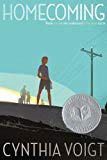
Homecoming is a young adult novel which tells the story of the four Tillerman children - Dicey, Sammy, James, and Maybeth - after they are abandoned by their mother in a Connecticut mall parking lot. Not knowing where to turn, the four children decide to walk to Bridgeport, almost a hundred miles away, where they believe their closest relative is living. They endure both hunger and danger along the way, but the children's long journey eventually ends when they end up with their grandmother in Maryland.
Already have an account? Log In Now